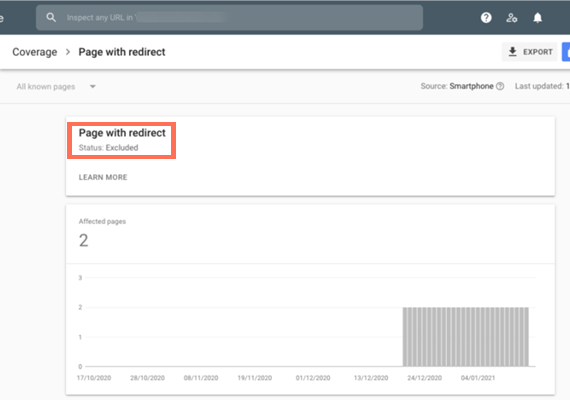What is a "Page with Redirect"
A "Page with Redirect" status in Google Search Console (GSC) indicates that a specific URL on your website redirects users (and search engine crawlers) to a different location. This redirection happens behind the scenes, essentially forwarding visitors to the new destination.
Why Does "Page with Redirect" Appear in GSC?
There are several reasons you might see this status for pages on your website:
- Planned Redirects: You might have intentionally set up redirects for various reasons. Maybe you moved content to a new URL (301 redirect) or permanently removed outdated content (301 redirect).
- Accidental Redirects: Technical issues on your website can cause unintended redirects. This could be due to typos in code, plugin conflicts, or server misconfigurations.
- Conflicting URLs: Sometimes, you might have duplicate URLs with slight variations (with or without trailing slashes). These often get automatically redirected to a canonical version by your server.
Is "Page with Redirect" a Problem?
Not necessarily. Redirects are a common practice, and GSC simply informs you that these redirects exist. However, there are situations where "Page with Redirect" can be problematic:
- Important Pages Being Redirected: If a crucial page for your website (like a product landing page) is being redirected, it might not get indexed properly by Google, impacting your search ranking.
- Broken Redirects: If a redirect malfunctions, it can lead to users encountering error pages (404 Not Found) instead of reaching the intended destination.
How to Resolve "Page with Redirect"
Identify the Redirected Pages: In GSC, go to the "Coverage" section and check the "Page with redirect" status. This will list the affected URLs.
Evaluate Each Redirect: Analyze why each page is being redirected. Was it intentional (301 redirect) or accidental?
Fix Unnecessary Redirects: If a redirect is unintentional, identify the technical cause and fix it. For example, update code or address plugin conflicts.
Review Important Redirected Pages: If a critical page is being redirected, consider:
- Keeping the Original URL: If the original URL is still relevant, remove the redirect and ensure the content is accessible at the original location.
- Verifying the Target URL: If the redirect is necessary, double-check that the target URL functions properly and accurately reflects the original content.
Solutions for "Page with Redirect"
Here are some solutions depending on the situation:
Fix Server-Side Redirects: If the redirect is happening on your server, access your server configuration or CMS settings to adjust or remove the redirect rule.
Modify Plugin Settings: If a plugin is causing the redirect, check its settings and disable the redirection functionality.
Update Internal Links: If you changed the URL structure and implemented redirects, update any internal links on your website pointing to the old URLs.
Utilize Canonical Tags: Guide search engines to the preferred version of a duplicate URL by using a canonical tag on the primary page.
Test After Changes: After making adjustments, test your website to ensure the redirects work as intended and don't lead to broken links.
10 Frequently Asked Questions about "Page with Redirect"
- Do all "Page with redirect" statuses require fixing?
No, not all redirects are problematic. If the redirects are intentional (301 redirects) and lead to relevant content, you can often leave them as is.
- How can I differentiate between intentional and accidental redirects?
Analyze the URLs and content involved. Intentional redirects likely lead to thematically similar content. Look for technical explanations or documentation related to website migrations for planned redirects.
- What redirect types should I be aware of?
There are different redirect types, with the most common being:
* **301 Redirect:** Indicates a permanent move of content to a new location.* **302 Redirect:** Used for temporary redirects. * **Meta Refresh Redirects:** Redirects implemented using HTML meta tags (generally discouraged).- Can redirects affect my website's SEO?
Excessive redirects can create a chain effect, slowing down website loading times and making it harder for search engines to crawl and index your content.
- What tools can I use to identify redirects?
Several online tools and browser extensions can help you detect redirects on your website.
- Is it bad to have multiple redirects for a single URL?
Yes, having multiple redirects (redirect chains) can be inefficient and negatively impact SEO. Aim for a maximum of one redirect per URL for optimal performance.
- What happens if I remove a redirect but still see the "Page with redirect" status?
It can take some time for search engines to recrawl your website and update their index. Be patient and allow Google to process the changes. You can submit a sitemap or request reindexing in GSC to expedite the process.
- How can I prevent "Page with redirect" issues in the future?
Here are some preventive measures:
* **Plan redirects carefully:** Before implementing redirects, consider the impact on SEO and user experience.* **Test redirects thoroughly:** Ensure redirects work as intended before making them live.* **Maintain a consistent URL structure:** Avoid frequent URL changes that necessitate redirects.* **Monitor your website:** Regularly check GSC and other tools for "Page with redirect" issues.- Should I redirect all old blog posts to the homepage after a website redesign?
Not necessarily. Redirecting all old content can dilute the value of your homepage and negatively impact SEO for those specific posts. Consider redirecting only relevant posts or keeping them accessible through proper internal linking.
- What if I'm unsure how to fix a "Page with redirect" issue?
If the issue seems complex or you're uncomfortable making technical changes, consider seeking help from a web developer or SEO specialist. They can diagnose the problem and implement the necessary solutions.
By understanding redirects and how to manage them effectively, you can ensure your website functions smoothly and maintains good search engine visibility.









Social Plugin